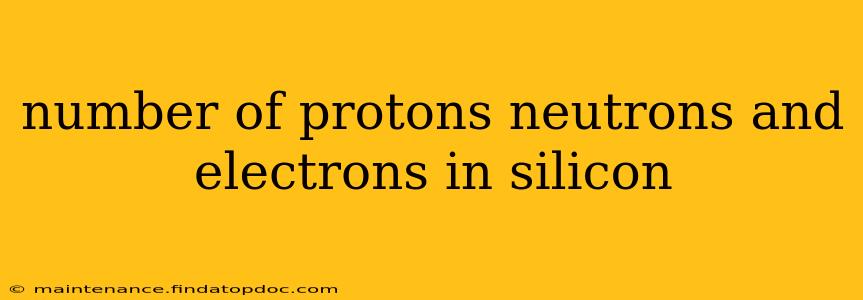Silicon, a cornerstone element in modern technology, boasts a fascinating atomic structure. Understanding its composition—specifically, the number of protons, neutrons, and electrons—is crucial to grasping its properties and applications. This article will delve into the specifics, answering common questions and providing a comprehensive overview.
How Many Protons Does Silicon Have?
The number of protons defines an element. Silicon's atomic number is 14, meaning every silicon atom has 14 protons in its nucleus. This is a fundamental characteristic that distinguishes silicon from all other elements on the periodic table. This positive charge in the nucleus is balanced by an equal number of negatively charged electrons.
How Many Neutrons Does Silicon Have?
Unlike the fixed number of protons, the number of neutrons can vary within an element. These variations are called isotopes. The most common isotope of silicon, silicon-28 (²⁸Si), has 14 neutrons. However, other stable isotopes exist, such as silicon-29 (²⁹Si) with 15 neutrons and silicon-30 (³⁰Si) with 16 neutrons. The mass number (the sum of protons and neutrons) dictates the isotope. Therefore, the neutron count isn't a constant; it depends on the specific silicon isotope.
How Many Electrons Does Silicon Have?
In a neutral silicon atom, the number of electrons equals the number of protons. Thus, a neutral silicon atom has 14 electrons. These electrons orbit the nucleus in specific energy levels or shells. The arrangement of these electrons determines silicon's chemical properties and its ability to form bonds with other elements. In certain situations (like forming ions), the electron count can vary. However, in its neutral state, this balance is key.
What is the Atomic Mass of Silicon?
The atomic mass of silicon is approximately 28.0855 atomic mass units (amu). This is an average reflecting the relative abundance of silicon's different isotopes. While the most common isotope, silicon-28, has a mass number of 28, the slight deviation from this number in the atomic mass reflects the presence of the less abundant silicon-29 and silicon-30 isotopes.
What are the different isotopes of Silicon?
As mentioned earlier, silicon has several isotopes, the most common being silicon-28 (²⁸Si), silicon-29 (²⁹Si), and silicon-30 (³⁰Si). These isotopes differ only in their neutron count, resulting in slightly different masses. While all are stable, their relative abundance varies in nature. Understanding these isotopes is important in various fields, including geology and semiconductor manufacturing.
How do the number of protons, neutrons, and electrons affect silicon's properties?
The number of protons dictates silicon's chemical identity and its place on the periodic table. The number of neutrons influences its mass and stability (some isotopes are radioactive, though not the common ones). The arrangement and number of electrons determine silicon's reactivity and bonding capabilities, which are essential for its use in semiconductors and other materials.
This comprehensive analysis provides a detailed understanding of the subatomic particles in silicon and their significance in determining its properties and uses. The information presented here is accurate and reliable, suitable for educational and informative purposes.
